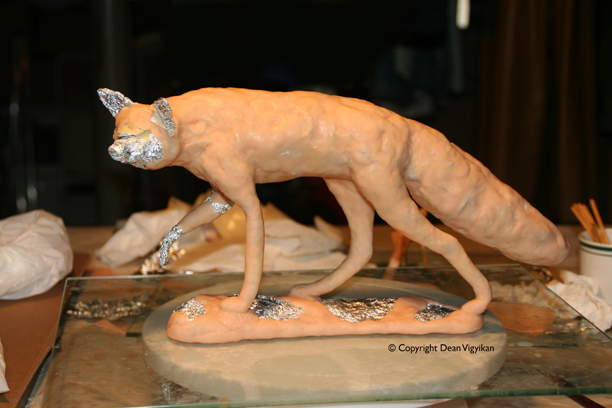Building Sculpture with Polymer Clay
Sculpture is one of my favorite art forms to work in. There are many various media to choose from in creating sculpture – everything from bronze to found objects from around the house. One of the most interesting, thanks to modern technology, is polymer clay. As the name suggests, this amazing material uses plastic chemistry to provide artists and crafts people with a versatile, pliable medium capable of nearly anything traditional clay can do, and sometimes more!
A while ago, I wrote an article about a live demo I provided for visitors to the beautiful Chestnut Ridge Park in Western New York. For this event, I built an armature (or framework) of aluminum wire and foil, around which I would sculpt a fox as part of a fantasy art piece I had in mind. Below, you can observe a phase of the project as it appeared shortly after the demo at the park. It’s basically a fox skeleton. The tan-colored clay around the armature has been baked in the oven after being applied, which hardened the clay. What a wonderful concept!

With commissioned work to complete and deadline-sensitive art to create, I had to set the fox sculpture aside for many months before returning and finishing the piece. By carefully following a series of phases I conceived for the project, I was able to realize my original vision of a delicate fairy riding on the back of the fox like a child going for a pony ride. A separate armature had to be created for the fairy. One of the beauties of sculpting with polymer clay is that, in many instances, it can be baked multiple times and retain its structural integrity. That way, an artist can work on a highly detailed piece in phases, without fear of damaging carefully rendered work which has already been completed.

The material comes in many brands and colors. Earlier this year, I completed another polymer clay sculpture of the Apostle Peter walking on water. It was sculpted using a brand called Primo! polymer clay which I enjoy immensely. For that piece I chose a color they call “raw sienna.” I personally think it looks more like burnt sienna in the world of painting but, either way, it’s a gorgeous earthy hue. For this fox and fairy sculpture entitled A Walk in the Woods, I chose a different brand of material called Cernit, which comes in a much lighter, tan-flesh color. In addition to varying in colors available, the workability of the two brands is also somewhat different, each having its own unique strengths, as well as sharing similarities between them. Of course there are numerous other brands available as well.
The detail that can be achieved in polymer clay is very satisfying, along with the ability to exercise many of the fine art sensibilities of traditional sculpture. As well as fine art, this material is also used in commercial art applications and in crafts. The finished results can be exhibited and collected like any other art piece, or later cast in bronze or some other material, if the artist chooses to do so. Not only does A Walk in the Woods exhibit a lot of surface detail, but there’s also an interesting translucent effect when areas such as the wings are illuminated with backlighting.
Among so many media I enjoy, polymer clay is definitely one of them. Its versatility and ease of completion in a home oven make it attractive and accessible to many artists in the fantasy genre among others who want to be able to express their active imaginations with ease and convenience. I hope to have many further opportunities to sculpt with this miracle of technology.

Greetings Dean,
First off, your work is *excellent*. I stumbled upon this piece and really appreciate the craftsmanship. That said, could you share, in general, what method you used to create strong wings for your fairy? Did you pass a single wire through the shape? Thanks in advance for your reply. -Nat 🙂
Hi Nat,
Thank you! I appreciate your comments. Your thought about the wire is a good one. In this case there’s actually no wire in the wings. I flattened out the clay and cut out the wing shapes. After working some gentle folds into them I baked them on a bed of Poly-Fil. Then I coated the wings with a thin layer of Sculpey Bake & Bond, added a second layer of clay on top of that with the details and veins included, and baked it again. I hope that helps 🙂 You’re sure welcome, and feel free to check in again!
– Dean